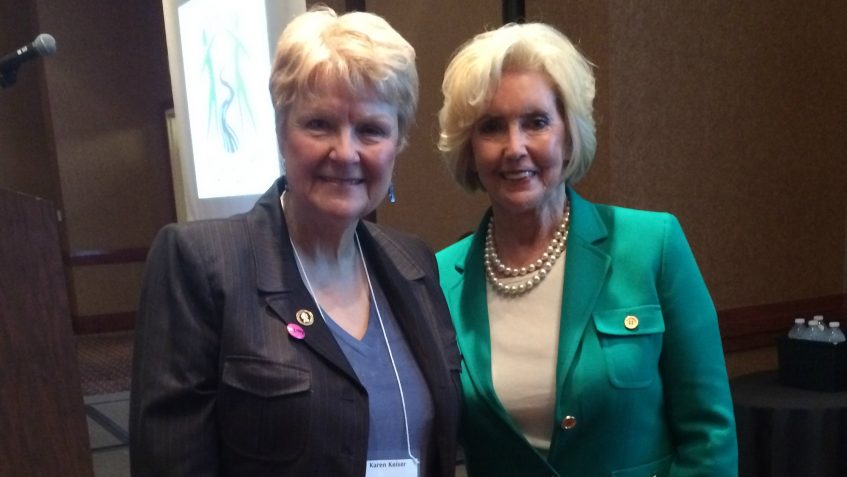I had the very special privilege of speaking at the American Association of University Women’ regional convention Friday on a panel discussion of pay equity issues. That’s an important topic, but what made the evening even more memorable was the participation of Lilly Ledbetter, a personal heroine of mine, whose lawsuit against the Goodyear Tire & Rubber Co. led to the Lilly Ledbetter Fair Pay Act of 2009 to make it less onerous for women to sue for pay inequity.
These were my comments Friday:
In Washington state, a woman who holds a full time job is paid, on average, $41,062 dollars per year. A man who holds the same full-time job is paid $52,529 dollars per year. That amounts to an annual wage gap of $11,467.
That gap then begs the question: what would closing the wage gap mean in real terms for the average working woman?
The difference would equal seven more months of mortgage and utilities payments, or … 12 more months of rent! Every year! This is no small matter.
The wage gap is sometimes excused by pointing out that women are predominantly employed in low-wage industries, while men are predominantly employed in higher-wage industries. For example, in Washington state, women account for 56 percent of all minimum wage earners.
In the Seattle area, we have a big concentration of high-tech, engineering and science jobs, all of which are more likely to be held by men. However, the stubborn wage gap persists even within these industries. In the professional, technical and scientific fields, women continue to earn only 65 percent of what their male counterparts are paid. That’s a bigger wage gap than the national average of 78 percent.
That fact is just stunning, and belies the movement to encourage more girls to study science, math, engineering and computer science. Although education has a positive impact on women’s earnings, and helps narrow the wage gap … it only accounts for a small part of the gap. Just about 7 percent of the wage gap can be attributed to education. This is such a disappointment to those of us who want to believe that education is the path to equal opportunity. It is a narrow path.
Another excuse commonly used to justify the wage gap is that women are more likely to take breaks from the workforce for caregiving and are more likely to work part time to balance family duties. But this labor force participation difference accounts for only 10.5 percent of the wage gap.
However the wage gap is sliced and diced, we still end up with a very substantial portion of this gap — about 40 percent — with no explanation except the obvious one: gender discrimination. This is why wage transparency laws will have such a big impact — especially on the women in our country. When women realize that the man doing the same job in the next room is earning a lifetime of higher wages, she will act. And we need to act!
We stopped talking about sex discrimination about 15 years ago. Maybe we thought we had achieved our goals when we elected so many women in the 1992 “year of the woman” and in the decades since, when every sport and every occupation seemed to mark a first woman milestone … from Ride Sally Ride to the Mom in Tennis Shoes making it all the way to the U.S. Senate, the old-boys club of yore.
Whenever we stop talking about discrimination against women, we start losing ground. Much like the myth of Sisyphus — if you stop pushing that rock up the mountain, it rolls back down on you. Personally, I think we have stumbled on that big rock, and need to start pushing back again.
When I joined the Washington State Senate in 2001, we had 18 women members in the Senate Democratic Caucus. Today, we have just nine — our ranks have been reduced by 50 percent. We had a female governor and state superintendent of public instruction, even a female insurance commissioner. Now we have only one woman who is a statewide elected official — Secretary of State Kim Wyman.
Why does this matter? It means that policies that would help working women and their families thrive have stalled. In 2002, I was able to pass the Family Care Act into Washington state law. This law allows workers to use their earned sick leave to care for ill family members.
But in the decade since, we have been unable to pass paid sick leave as a job standard for all. A paid sick leave bill did pass the state House last session, but it could not even get out of committee in the Republican-dominated Senate.
How is paid sick leave linked to pay equity? More than half of women workers do not get paid sick time on the job. If they get sick, or have an ill child, they face the impossible choice of losing a day’s pay or going to work leaving a sick child at home alone. Maybe they go to work with a contagious virus that will spread to others.
A bill to increase the minimum wage in our state to $12 over the next three years provides another example of a policy that would have helped women. Senate Democrats were unable to move it forward into law last year. This is particularly important because women make up 56 percent of minimum wage workers, and many of them are the sole breadwinners for their families.
Funding our state’s paid family leave law provides yet another example of a policy that has stalled to the detriment of working families. The Family Medical Leave Act has been a success story, but it is limited to families that can afford to go without a paycheck for up to 12 weeks. As Democrats, we have sponsored several bills to provide partial wage replacement for up to 12 weeks for an individual or family member’s serious health condition or for the birth or adoption of a child into a family.
All these proposals have been introduced and re-introduced for nearly a decade without making it to the governor’s desk.
The wage gap is not a new phenomenon. It has existed since women have been in the workplace — and has been pretty stable for the last two decades. Real progress on closing the wage gap has been excruciatingly slow and is projected to remain so unless we change the status quo.
Experts warn that we will not close the gap in our lifetime. If change continues at the pace that it has during the past 50 years, it will take at least 50 MORE years for women to reach pay equality with men.
As a politician, I am an optimist. And new analysis by that wunderkind numbers cruncher, Nate Silver, gives us some data that I hope can steer us in the right direction.
Silver found a direct correlation with female representation in state legislative bodies and gender pay equity.
In states where the pay gap is the widest — Wyoming, Louisiana, West Virginia, Utah and Alabama — women occupy an average of just 15 percent of the seats in those states’ legislatures.
But in states with the narrowest pay gaps — Maryland, Vermont, New York, Nevada and the District of Columbia — women represent 30 percent of the Legislature. In Washington state, we were at one point in the 1990s the state legislature with the highest number of women lawmakers, at about 40 percent.
I’m sorry to tell you that ratio has fallen; on my side of the aisle, women now represent just 25 percent of the caucus. There has been an increase in Republican women, but they generally do not support policies to ensure reproductive choice, paid sick leave or higher minimum wages.
So … I want to suggest to you that the relationship between the gender pay gap and a state’s political environment gives us a clear road map to real progress.
We have an opportunity today to begin to change the status quo. We don’t have to accept the gender pay gap — and we shouldn’t.
I know that someday in our lifetimes — and that means not waiting another 50 years — we can make it a reality in our country that women will be compensated not on the basis of their gender but on their job performance, their accomplishments and their skills.
Thank you for the AAUW ‘s commitment for equal opportunity and equal pay for equal work.





